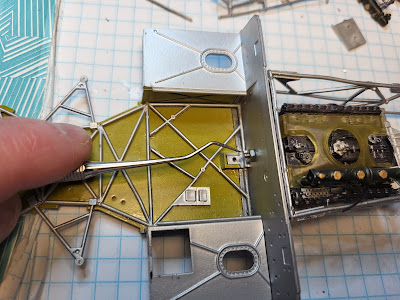A Facebook colleague asked me to help him out with the devilishly complex 1/24 scale Model Factory Hiro kit of the devilishly complex Porsche 917/30 as driven by Mark Donohue. Specifically, the paint has been done, and the engine started; and as paint is my least favourite part of this hobby, I agreed. So the owner of the kit mailed it to me and it turned up about a week ago.
First step was to disassemble the engine as I intend to paint and detail it, even if none of it will be visible once complete. I gently pried off the lovely semi-translucent fan shroud and tossed the rest into the acetone bath to dissolve the CA glue.
Then I got out my lovely new DC drill press and went to work with the 0.016" bit: 12 injectors, 12 injector ports on the injection pump, 24 spark plugs in the cylinder heads, 24 plug wires on the distributors, 4 coil wires on the distributors and 4 coils, all this without once breaking a bit or sliding off the part and driving the bit into my thumb.
Reassembly is progressing. But I know from experience that it is wise to ensure the engine, rear tubular chassis and cockpit tub all line up as early as possible, otherwise you wind up wrestling with a complete but delicate engine, in a complete but delicate chassis, to get it all to line up. So I also got started on these other components.This involved sorting through piles of flexible and poorly formed 1 mm diameter white metal tubing.
Eventually I got to the point of bolting the engine block and rear chassis to the cockpit tub, using a larger M2 stud and nut in place of the provided M1.4 x 3.0 screw. This shows that the rear engine mounts need to be moved forward about 2 mm, a good thing to know at this stage.
Stay tuned, this will only get better.

















